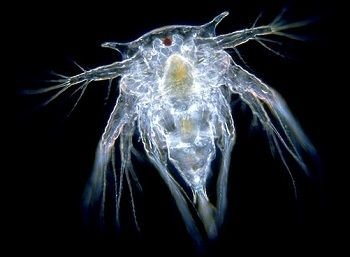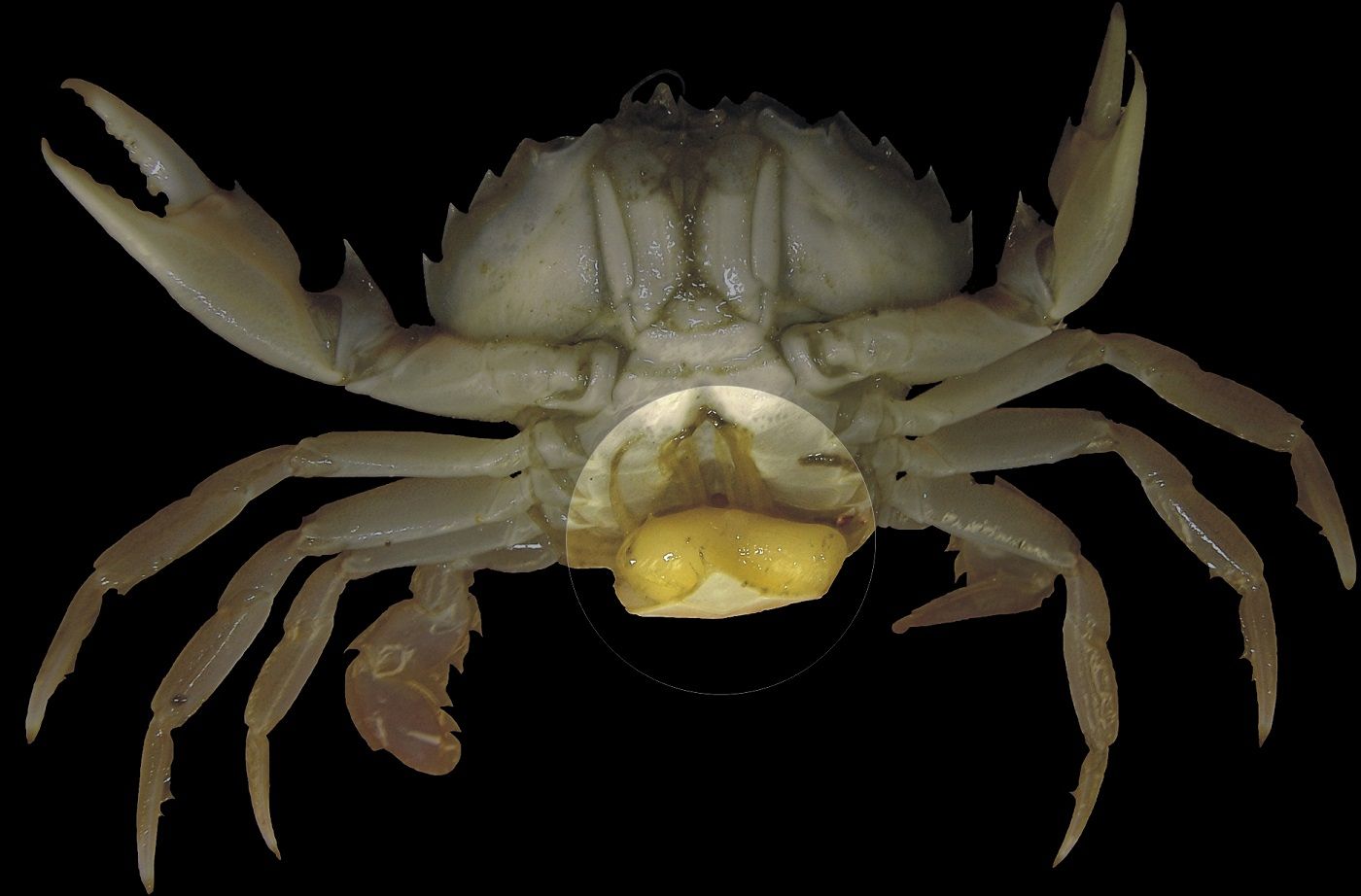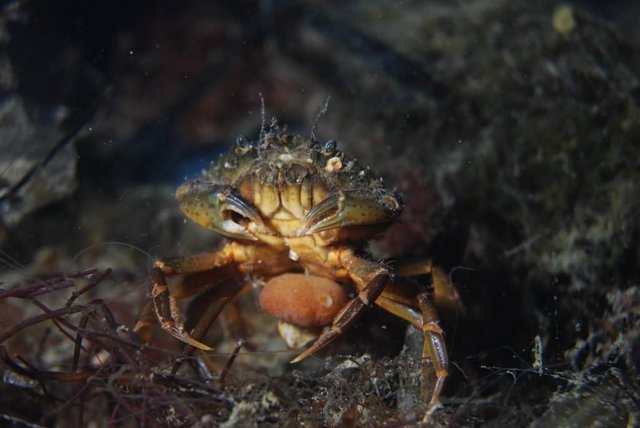Sacculina Carcini: Take Full Control Through The Transformation
I have written an artistic introduction for articles about parasites so many times, that I have run out of metaphors. But, I can guarantee that you will surprised again. Our guest is the kind of parasites that change their carriers completely and irrevocably and remain with them for life.

image source
Let me introduce Sacculina carcini- arthropod creatures from a detachment of crustaceans, which parasitize on crabs. The process of capture of the host and gain control over its body makes me think “Thanks God I’m Human!”.
Phase 1
 Sacculina at the stage of the nauplius
Sacculina at the stage of the nauplius
4-5 days after birth, the larva begins to grow a shell, this is a turning point for females. Sacculina should find a carrier (crab) as soon as possible to stay with him for life. With the help of special organs on legs, the larva catches the smell of a crab of a suitable species and begins actively flutter in the water, until she reach the victim's body.
Then the larva finds a suitable place to "enter", usually it is the joints on claw or damage in the shell. On this stage, the parasite undergoes an amazing metamorphosis. Sacculina drops her shell and simultaneously grows on her head an acute hollow spike.
Using the spike, the larva bites into the body of the crab and discards the rest of the body (trunk with all organs, limbs and shell). Through the cavity in the spike, she injects the head part into the body of the carrier.

Moving the parasite cells through the spike (Thecostraca (Crustacea) source
What is striking is that this parasite doesn’t leave any part of its body inside the host, but transfers itself in the form of a microscopic accumulation of cells, which later will develop into a complex parasitic system.
Phase 2
The cells of the parasite move into the nutrient medium of the intestinal tract of the carrier, and begin actively to divide and grow, forming a new parasite body with root-like appendages. Parasitic outgrowths gradually envelope all the organs of a crab and can even reach the eyeballs. Thus, we can see the organism completely different from the original larva.

A- Sacculina during the growth stage after anchoring in the intestine. B- primary stage of the larva. image source
Sacculina lives by absorbing nutrients from the blood of her carrier, not causing him critical harm. Infected crabs often live even longer than their healthy counterparts. Like many other parasites, Sacculina is trying to "care" about her carrier. Otherwise, with such type of a symbiosis, she will die with him.

The final stage of parasite development before reproduction. image source

The whole body of the carrier (inside) is entangled by parasitic growths.image source
Over time, the parasitic body expands so much that it climbs out in the area of the crab's belly (where female crabs carry their eggs). This is an adult formed female specimen of Sacculina in the form of a sack-like smooth outgrowth, without eyes, mouth and other visible organs. The carrier still does not feel serious discomfort and changes at this stage.
Phase 3
When Sacculina is ready for mating, she begins radically change not only the behavior of the host, but also his physiology:
- The crab stops shedding and discarding the shell, not to damage the sack on the belly. Also, the carrier stops growing.
- The parasite destroys the reproductive organs of the carrier (parasitic castration).
- The crab loses the ability to regenerate damaged claws (what is not difficult for healthy individuals).
Thus, the most energy-consuming abilities of the organism are disconnected in order to redirect the released resources into the body of the parasite. Now the parasite and its offspring will be able to obtain the necessary amount of nutrients. Not being able to reproduce, the crab spends all his forces to eat and cares about the outgrowth on his abdomen, which he perceives as own offspring.
Sacculina can parasitize on both sexes of crabs. If the male becomes the host, he begins to behave just like the female.
Then, Sacculina begins to spread pheromones and on her body opens a tiny hole for the penetration of the male. Free-swimming males of the parasite has time to build up the shell during its short life. So to crawl through the hole and reach the eggs, they use the previously described strategy of their partners - discard most part of the body.
10 hours later after penetration, the male reaches the destination, along the way dropping the remains of the shell. For the rest of his life he will live deep in the body of the female, continually producing sperm to fertilize the eggs. Usually Sacculina able to accept two males, to increase the heterozygosity of offspring.
The crab-carrier continues to care about the outgrowth on his stomach, removing with it the algae and fungi. When the larvae are ready to leave the mother's body, the crab finds a high rock, climbs on it and starts swinging his claws in different directions. Thus, he creates an additional flows which helps the offspring of Sacculina to leave the bag and get into the ocean currents, to repeat the cycle…

image source
***
As I said, in my opinion, this type of parasites is the most frightening and amazing at the same time. Imagine that another organism does not just live at the expense of the basic processes that take place in your body, but changes your body and behavior drastically, for his own purposes. In this case, the body of the carrier is not just an incubator, but a full-fledged organism, taken under full control. In fact, the parasite becomes the pilot of the new super-body, which significantly expands its capabilities.

image source
sources: Sacculina WiKi, Nauplius, NatGeo. Zombie Crab, www.ncbi.nlm.nih.gov, Sacculina carcini, ianimal, Parasitologyblog images from Google Search.

Yikes. This parasite "cares" for its host so that it lives long as you say...personally if I were the crab id prefer just to die early if this thing got me. Makes me glad im not a crab anyways.
Great article.
Keep in mind that this parasite changes your cognitive ability. You would have thought you are pregnant and must to protect your offspring in the first place :)
Wow I did not know this. This sort of reminds me of the wasp (can't remember the name) which lays it's eggs inside of a caterpillar. the only difference being the caterpillar ends up dead... Thanks for sharing @natord once again another great post.
This wasp? :) Many creatures use their prey as a cocoon for posterity, it is also pretty creepy.
And there you go another wasp that uses a similar strategy to reproduce the Tarantula hawk. This was actually what i was talking about just did some searching and the name potter wasp came up. But the tarantula wasp is something else there... and yes they are creepy but amazing nonetheless.
All of your information is incredible and well researched, keep up dude and keep sharing like this in future, I appreciate your work.
Thank you, I am very pleased to hear such kind words!
Always my pleasure
wow I really like it, the post you share is very good,
thank you so much for sharing useful postings,
Thank you for reading and following :)
interesante organismo parasitario. Saludos @natord.
Wow, the world is full of many strange creatures. regards @natord